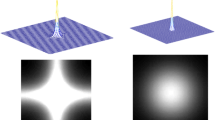Abstract
New methodology for pattern recognition is presented which is based on design of invariant reference points. It is shown that the k-NN distance classifier is a special case of this methodology. New classifiers within this framework are also described.
The work was sponsored by the grant of Institute of Radioelectronics
Preview
Unable to display preview. Download preview PDF.
Similar content being viewed by others
References
C. Bishop (1995) Neural Networks for Pattern Recognition, Clarendon Press, Oxford.
K.I. Diamantaras, S.Y. Kung (1996) Principal Component Neural Networks, John Wiley & Sons, New York.
R.O. Duda, P.E. Hart (1973) Pattern Classification and Scene Analysis, Wiley, New York.
Y. Fisher, ed. (1995) Fractal Image Compression — Theory and Application, Springer Verlag.
S. Haykin (1994) Neural networks — A Comprehensive Foundation, Maxwell Macmillan International.
H. Hotelling (1933) Analysis of a complex of statistical variables into principal components, Journal of Educational Psychology 24, 417–441.
A. Jacquin (1992) Image coding based on a fractal theory of iterated contractive image transformations, IEEE Transactions on Image Processing, 1, 18–30.
T. Kohonen (1995) Self-Organizing Maps, Springer, Berlin.
Y. Linde, A. Buzo, R.M. Gray (1980) An algorithm for vector quantizer design, IEEE Trans. Comm., COM-28 1980 28–45.
E. Oja (1983) Subspace methods of pattern recognition, Research Studies Press, England.
B.D. Ripley (1996) Pattern Recognition and Neural Networks, Cambridge University Press, Cambridge.
Author information
Authors and Affiliations
Editor information
Editors and Affiliations
Rights and permissions
Copyright information
© 1998 Springer-Verlag Berlin Heidelberg
About this paper
Cite this paper
Ignasiak, K., Skarbek, W. (1998). Pattern Recognition by Invariant Reference Points. In: Polkowski, L., Skowron, A. (eds) Rough Sets and Current Trends in Computing. RSCTC 1998. Lecture Notes in Computer Science(), vol 1424. Springer, Berlin, Heidelberg. https://doi.org/10.1007/3-540-69115-4_44
Download citation
DOI: https://doi.org/10.1007/3-540-69115-4_44
Published:
Publisher Name: Springer, Berlin, Heidelberg
Print ISBN: 978-3-540-64655-6
Online ISBN: 978-3-540-69115-0
eBook Packages: Springer Book Archive




